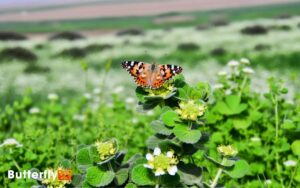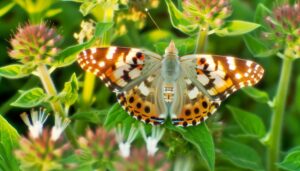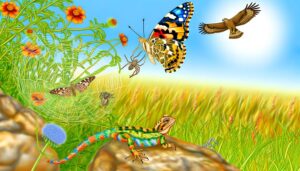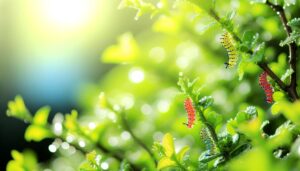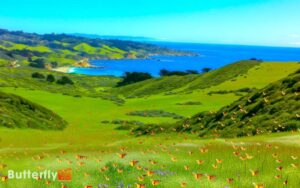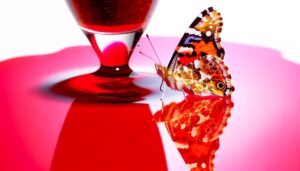Painted Lady Butterflies of Georgia: Discover Their Journey!
The Painted Lady butterfly (Vanessa cardui) flourishes in Georgia’s varied ecosystems, from urban gardens to rural meadows.
Recognized by its orange, black, and white patterned wings, it showcases four distinctive eyespots on each hindwing for predator defense.
Females are larger than males and exhibit complete metamorphosis, evolving from egg to larva to pupa to adult. These butterflies undertake long-distance migrations driven by climatic cues, covering up to 3,000 miles.
They play important roles in pollination and local food webs. To understand more about their fascinating migratory patterns and conservation needs, further exploration is encouraged.
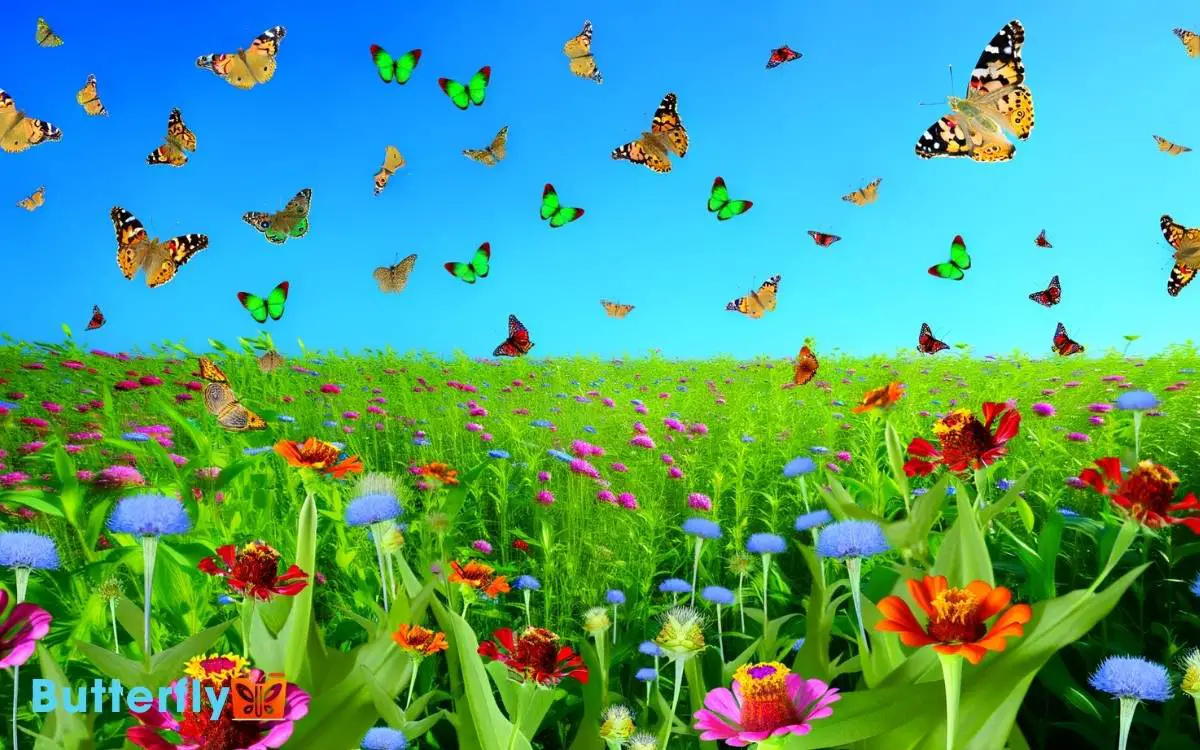
Key Takeaways
Identification and Appearance
The Painted Lady butterfly (Vanessa cardui) can be identified by its distinctive orange, black, and white patterned wings.
The forewings exhibit a complex arrangement of black spots and a prominent white bar. The hindwings are decorated with eye-like spots that serve as a defense mechanism against predators.
This species belongs to the Nymphalidae family, known for their brush-footed characteristics. Measuring approximately 5-9 centimeters in wingspan, Vanessa cardui displays sexual dimorphism, where females are generally larger than males.
The underside of the wings features a more muted palette of browns and grays, aiding in camouflage when the butterfly is at rest. Detailed observation reveals a finely scaled texture, indicative of the Lepidoptera order’s intricate wing structure.
Life Cycle Stages
Painted Lady butterflies undergo a complete metamorphosis, encompassing four distinct life cycle stages: egg, larva, pupa, and adult.
Females deposit their eggs singly on host plants, usually thistles. These pale green, barrel-shaped eggs hatch in about 3-5 days.
The larva, or caterpillar, emerges and begins feeding voraciously on the host plant’s foliage. This stage, lasting 5-10 days, involves multiple molts as the caterpillar increases in size.
After reaching its final larval instar, it forms a chrysalis, entering the pupal stage. This phase, lasting approximately 7-10 days, involves significant internal transformation.
Migration Patterns
Migration patterns of Vanessa cardui, renowned for their long-distance travel, exhibit remarkable navigational precision and seasonal predictability. These butterflies undertake extensive migrations, often spanning continents.
In Georgia, they generally move northward in spring and southward in autumn. This cyclical migration is driven by climatic conditions and resource availability. Vanessa cardui relies on environmental cues such as temperature gradients and wind patterns to navigate.
Their migratory behavior guarantees they exploit ideal habitats for breeding and feeding. Tracking studies using isotopic analysis and GPS tagging have revealed that these butterflies can cover distances up to 3,000 miles.
Their ability to maintain a consistent direction despite variable weather conditions showcases an advanced evolutionary adaptation for survival.
Habitat and Distribution
Where do Vanessa cardui find their preferred habitats in Georgia’s diverse ecosystems?
These butterflies thrive in open areas, including meadows, fields, and disturbed lands. Vanessa cardui are highly adaptable, inhabiting regions from coastal plains to mountainous areas.
They favor environments rich in their larval host plants like thistles (Cirsium spp.) and mallows (Malva spp.).
Adult Painted Ladies exhibit a preference for sunny spots with abundant nectar sources such as asters (Asteraceae) and clovers (Trifolium spp.). Observations indicate their widespread distribution across Georgia, from urban gardens to rural landscapes.
Ecological Role
The Painted Lady butterfly (Vanessa cardui) plays a vital role in pollination, facilitating genetic exchange among diverse angiosperms across Georgia.
Its larval and adult stages interconnect with the food web, serving as prey for various avian species and predatory insects.
These interactions highlight the species’ significance in maintaining ecological balance and biodiversity.
Pollination and Plant Relationships
Painted Lady butterflies (Vanessa cardui) play an essential role in Georgia’s ecosystems by actively pollinating a diverse array of native flowering plants.
Vanessa cardui exhibits a crucial feeding behavior, which allows it to visit multiple plant species, including Asteraceae and Fabaceae families.
This behavior promotes cross-pollination, enhancing genetic diversity within plant populations. Their proboscis effectively extracts nectar from tubular flowers, ensuring pollen transfer.
Observations show that these butterflies frequent common plants like thistles (Cirsium spp.) and sunflowers (Helianthus spp.), contributing to their reproductive success.
Additionally, the Painted Lady’s migratory patterns facilitate long-distance pollen dispersal, linking disparate plant communities.
Consequently, Vanessa cardui significantly strengthens the structural integrity and resilience of Georgia’s native flora through its pollination activities.
Food Web Contributions
Vanessa cardui not only enhances plant reproduction but also serves as an essential prey species within Georgia’s food web, supporting a variety of predators, including birds, spiders, and parasitoid wasps.
Their larvae, known as caterpillars, are particularly vulnerable, providing a significant food source for these predators.
Adult butterflies contribute to predator diets as well, especially for avian species. This trophic interaction underscores V. cardui’s role in maintaining ecological balance.
Additionally, their predation helps regulate their population, preventing overgrazing on host plants like thistles and mallows.
By acting as both pollinators and prey, V. cardui exemplifies a dual ecological role, vital for sustaining biodiversity and ecosystem functionality within Georgia’s diverse habitats.
Threats and Conservation
The Painted Lady butterfly (Vanessa cardui) faces significant threats from habitat loss due to urbanization and agricultural expansion.
Predation by birds and parasitism by wasps further exacerbate population declines.
Conservation efforts must prioritize habitat restoration and the implementation of protective measures to guarantee the species’ survival.
Habitat Loss Impact
Habitat degradation poses a significant threat to the Painted Lady butterfly (Vanessa cardui) populations in Georgia, necessitating urgent conservation efforts.
Urbanization and agricultural expansion have resulted in the loss of native flora, important for larval development and adult sustenance. The reduction of nectar sources and breeding sites disrupts their life cycle, leading to population decline.
Fragmented habitats impede migration and genetic diversity, essential for species resilience.
Efforts to mitigate these impacts must address:
- Destruction of wildflower meadows
- Conversion of natural lands to agriculture
- Use of pesticides and herbicides
- Climate change altering plant phenology
- Pollution affecting larval food plants
Conservation strategies must focus on habitat restoration, pollution control, and public awareness to sustain Vanessa cardui populations.
Predators and Parasites
Among the myriad threats to Painted Lady butterflies in Georgia, predation and parasitism by natural enemies significantly impact their populations.
Tachinid flies (family Tachinidae) and parasitic wasps, particularly from the family Braconidae, are major culprits. Tachinid flies lay eggs on caterpillars, with emerging larvae consuming the host from within.
Similarly, parasitic wasps inject their eggs into caterpillars, where larvae develop and eventually kill the butterfly larvae.
Generalist predators like birds and spiders also prey on both immature and adult butterflies. These biotic pressures, combined with environmental stressors, greatly reduce Painted Lady survival rates.
Understanding these interactions is crucial for developing effective conservation strategies and ensuring the health of Vanessa cardui in Georgian ecosystems.
Conservation Efforts Needed
Despite their resilience, Painted Lady butterflies (Vanessa cardui) face significant threats in Georgia that necessitate targeted conservation efforts. Habitat loss due to urbanization and agricultural expansion critically reduces larval host plants and nectar sources.
Pesticide use detrimentally impacts both larval and adult stages, disrupting reproductive cycles. Climate change alters migratory patterns and phenology, leading to mismatches in timing between butterflies and their food sources.
Conservation efforts must address these challenges urgently.
- Urban sprawl erodes critical habitats.
- Pesticides decimate populations indiscriminately.
- Climate change disrupts migratory synchrony.
- Agricultural practices reduce biodiversity.
- Pollution contaminates essential resources.
Observing Tips
When observing Painted Lady butterflies in Georgia, one should focus on their distinct wing patterns and coloration to accurately identify them from other species.
The Painted Lady (Vanessa cardui) exhibits orange-brown wings with black and white spots. Observers should note the presence of four small eyespots on the underside of the hindwings, which are essential for identification.
Ideal observation times are during late summer and early fall when migration peaks.
| Trait | Description | Importance |
|---|---|---|
| Wing Coloration | Orange-brown with black and white | Key identifying feature |
| Eyespots | Four small on hindwings’ underside | Differentiates species |
| Flight Pattern | Erratic and fast | Behavioral identification |
| Habitat | Open fields, gardens, meadows | Common observation sites |
Accurate identification enhances ecological studies and conservation efforts.
Conclusion
In the grand tapestry of nature, Painted Lady butterflies (Vanessa cardui) in Georgia are vibrant threads, weaving through various life stages and migrations with precision. Their delicate wings, adorned with intricate patterns of orange, black, and white, flutter across meadows and gardens in a mesmerizing display. The painted lady butterflies journey spans thousands of miles, as they migrate seasonally in search of warmer climates and abundant food sources. Throughout their lifecycle, from caterpillar to chrysalis to adult, they play a vital role in pollination, contributing to the rich biodiversity of Georgia’s ecosystems.
Their ecological roles as pollinators and prey underscore their importance in the ecosystem. Yet, they face threats that demand our attention.
By understanding their habits and habitats, we can help guarantee these delicate marvels continue to flutter through our landscapes, a symbol of nature’s intricate balance and resilience.

